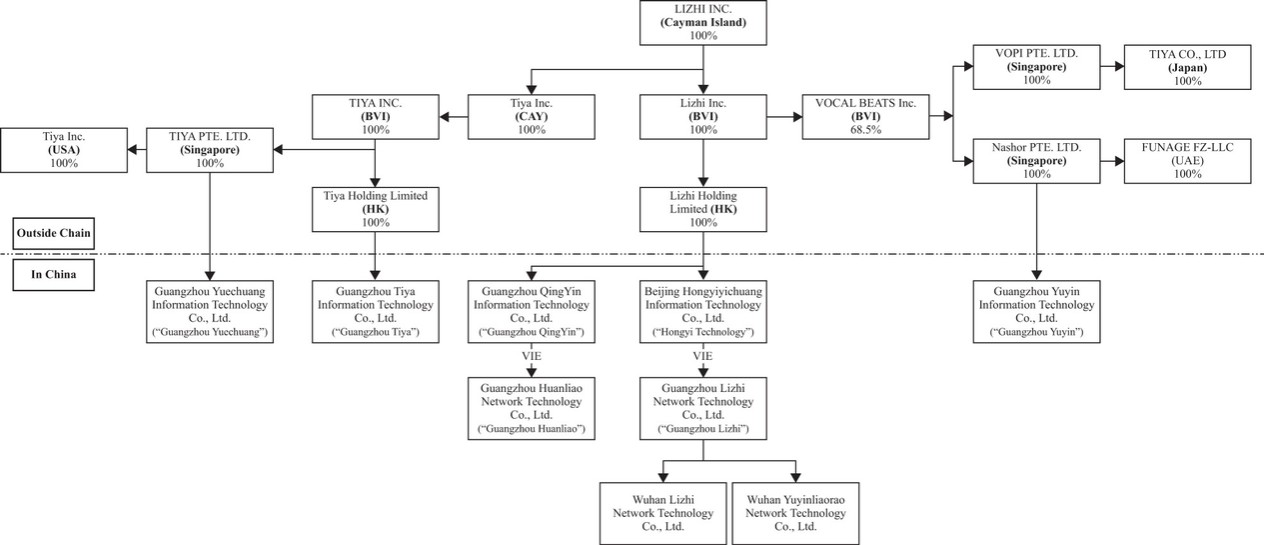We have also entered into an indemnification agreement with each of our directors and executive officers. Under these agreements, we agree to indemnify our directors and executive officers against certain liabilities and expenses incurred by such persons in connection with claims made by reason of their being a director or officer of our company.
Share Incentive Plan
In September 2018, Lizhi BVI adopted the 2018 Share Incentive Plan, or the 2018 BVI Plan. Under the 2018 BVI Plan, Lizhi BVI granted 27,765,900 options and restricted shares to its certain management members, employees and a consultant corresponding to 27,765,900 ordinary shares.
We adopted a share incentive plan on May 31, 2019, or the 2019 Share Incentive Plan, for the purpose of granting share based compensation awards to employees, directors and consultants to incentivize their performance and align their interests with ours. The 2019 Share Incentive Plan has replaced the 2018 BVI Plan in its entirety. All granted and outstanding awards under the 2018 BVI Plan have since been terminated.
We amended and restated the 2019 Share Incentive Plan on March 18, 2020, or the Amended and Restated 2019 Share Incentive Plan, to increase the maximum aggregate number of Class A ordinary shares we are authorized to issue under the Amended and Restated 2019 Share Incentive Plan to 100,000,000 Class A ordinary shares. On September 17, 2021, we adopted the Second Amended and Restated 2019 Share Incentive Plan to replace the Amended and Restated 2019 Share Incentive Plan in its entirety, increasing the maximum aggregate number of Class A ordinary shares we are authorized to issue under the Second Amended and Restated 2019 Share Incentive Plan to 170,000,000 Class A ordinary shares.
As of February 28, 2023, there are 86,290,620 options and restricted share units outstanding that were granted to certain management members, employees and consultant corresponding to 86,290,620 of our Class A ordinary shares pursuant to the Second Amended and Restated 2019 Share Incentive Plan. Among those, a total of 5,395,630 Class A ordinary shares corresponding to restricted shares units granted to certain of our management members and director, were held by Kastle Limited, a company incorporated with limited liability under the laws of Hong Kong, as of February 28, 2023. Kastle Limited holds such ordinary shares in trust for the benefit of these management members and directors.
The maximum aggregate number of shares which may be issued pursuant to all awards under the Second Amended and Restated 2019 Share Incentive Plan is 170,000,000 Class A ordinary shares. As of February 28, 2023, awards representing 86,290,620 Class A ordinary shares have been granted and outstanding under the Second Amended and Restated 2019 Share Incentive Plan. The awards issued under the Second Amended and Restated 2019 Share Incentive Plan are vested by equal instalment from nil to four years upon our initial public offering in January 2020.
The following paragraphs summarize the terms of the Second Amended and Restated 2019 Share Incentive Plan.
Types of Awards. The Second Amended and Restated 2019 Share Incentive Plan permits the awards of options, restricted shares and restricted share units, or other right or benefit authorized to be granted under the Plan.
Plan Administration. The Second Amended and Restated 2019 Share Incentive Plan is administered by our board of directors or committee or individuals authorized by our board. The plan administrator is entitled to determine the participants who are to receive awards, the number of awards to be granted, and the terms and conditions of each award grant.
Eligibility. Employees, directors and officers and the consultants of our company are eligible to participate pursuant to the terms of the Second Amended and Restated 2019 Share Incentive Plan.
Conditions of Award. The plan administrator shall determine the participants, types of awards, numbers of shares to be covered by awards, terms and conditions of each award, and provisions with respect to the vesting schedule, settlement, exercise, repurchase, cancellation, forfeiture, restrictions, limitations or suspension of awards.
Term of Award. The term of each award shall be fixed by the administrator and is stated in the award agreement between recipient of an award and us. No award shall be granted under the Second Amended and Restated 2019 Share Incentive Plan after ten years from the date the Second Amended and Restated 2019 Share Incentive Plan was approved by the board.
Vesting Schedule. In general, the plan administrator determines the vesting schedule, which is set forth in the award agreement.
